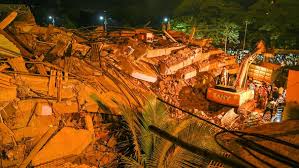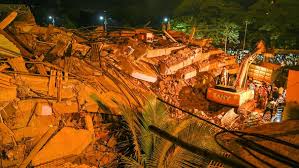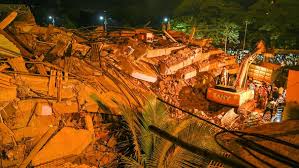building collapse
building collapse

Table of Contents
In a tragic incident that has shaken the nation, at least seven people were killed and several others are feared trapped after a multi-story residential building collapsed in the city of Mumbai, India, on the evening of August 10, 2024. The collapse,
which occurred in a densely populated neighborhood, has raised serious concerns about the safety of older buildings in the city and the effectiveness of regulatory measures meant to prevent such disasters.
The Incident: A Tragic Collapse
The building, located in the southern part of Mumbai, was a four-story structure that housed several families. According to eyewitnesses, the building began to show signs of distress in the early evening, with cracks appearing in the walls and loud creaking
noises emanating from within. Despite these warning signs, the collapse happened suddenly, giving residents little time to evacuate.
The structure came crashing down around 6:30 PM local time, sending a cloud of dust and debris into the air and leaving a scene of devastation. Neighboring buildings shook from the impact, and panicked residents rushed to the scene to help, even before emergency services arrived.
Emergency response teams, including the National Disaster Response Force (NDRF), Mumbai Fire Brigade, and local police, were quickly dispatched to the site. Rescue operations commenced immediately,
with rescuers sifting through the rubble in search of survivors. Heavy machinery was brought in to lift large concrete slabs, while rescuers worked tirelessly, often with their bare hands, to pull people from the debris.
The Victims: Lives Lost and Lives at Risk
As the rescue operations continued through the night, the death toll began to rise. By the next morning, authorities confirmed that at least seven people had lost their lives in the collapse. Among the dead were two children, highlighting the tragic impact of the disaster on families who had been living in the building for years.

Several others were pulled from the rubble alive, some with serious injuries. These survivors were rushed to nearby hospitals, where they received emergency medical care. The condition of some of the injured remains critical, and the number of casualties is expected to rise as rescue teams continue to search for those still missing.
The exact number of people trapped in the building at the time of the collapse remains uncertain. Initial reports suggest that up to 15 residents could
still be buried under the debris, but the chaotic scene and the extent of the damage have made it difficult for authorities to confirm these numbers. As hours pass, the chances of finding more survivors diminish, adding to the anguish of families waiting for news of their loved ones.
The Building: A History of Neglect
The collapsed building was more than 40 years old, and like many structures in Mumbai, it had a history of neglect and deterioration. Residents had reportedly complained about the building’s condition to local authorities on multiple occasions, citing structural issues, water leakage, and the visible deterioration of the walls and ceilings. Despite these complaints, no significant action was taken to repair or reinforce the building.
According to local sources, the building had been classified as “dilapidated” by the Brihanmumbai Municipal Corporation (BMC), the governing civic body of Mumbai, but had not been evacuated or earmarked for demolition. Instead, the building continued to house families, many of whom had lived there for decades.
This incident has once again brought to light the issue of aging infrastructure in Mumbai, a city known for its high population density and the significant number of old buildings that are still in use.
The pressure on housing in Mumbai has led many families to continue living in buildings that are structurally unsound, either due to a lack of affordable alternatives or because of delays in the redevelopment of such properties.building collapse
The Response: Rescue and Recovery
The response to the building collapse was swift, with emergency services arriving on the scene within minutes of the incident. The NDRF and fire brigade personnel have been working around the clock, using advanced equipment such as thermal imaging cameras, cranes, and cutters to locate and extricate survivors.building collapse
Local residents also played a crucial role in the immediate aftermath of the collapse. Many of them, familiar with the layout of the building, assisted rescuers in navigating the debris and identifying areas where survivors might be trapped. Their efforts were instrumental in the rescue of several individuals in the initial hours.building collapse
Despite the best efforts
Despite the best efforts of the rescue teams, the operation has been hampered by the instability of the remaining structure and the densely packed debris. Rescuers have had to proceed with extreme caution to avoid triggering further collapses, which could endanger both those trapped and the rescuers themselves.building collapse
As the rescue operation continues, authorities have cordoned off the area and are advising residents of nearby buildings to evacuate as a precautionary measure. Temporary shelters have been set up for those displaced by the collapse, and local NGOs and community groups have stepped in to provide food, water, and other essential supplies to the affected families.
The Investigation: Seeking Accountability
In the wake of the collapse, questions are being raised about the accountability of various stakeholders, including the building’s owners, the BMC, and other regulatory bodies responsible for ensuring the safety of buildings in Mumbai.
The BMC has announced that it will conduct an inquiry into the incident, focusing on the building’s maintenance history, the complaints lodged by residents, and the actions taken by officials in response to these complaints.
The building’s owners, who could face legal action if found negligent, have so far remained unavailable for comment. There is growing public anger and frustration over the apparent lack of enforcement of safety regulations and the failure to address the risks posed by aging buildings.building collapse
This is not the first time Mumbai has witnessed such a tragedy. Building collapses are a recurring issue in the city, particularly during the monsoon season when heavy rains exacerbate the structural weaknesses of older buildings.










